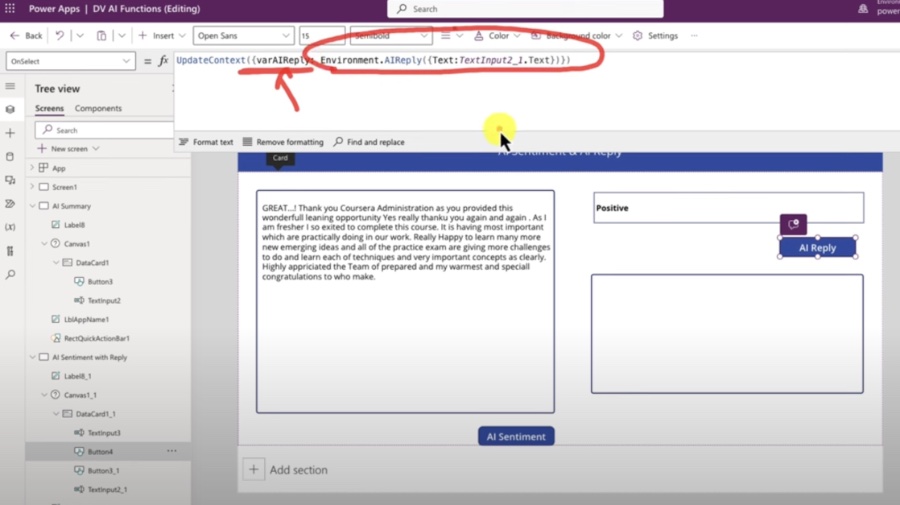How to use Dataverse AI Capabilities
Unleash Dataverse AI: Streamline Apps with Prebuilt AI Functions - Discover with Dhruvin Shah!
Key insights
- Dataverse provides a variety of ready-to-use AI functions that are preconfigured and don't require data collection, building, or training.
- These prebuilt AI functions can be integrated into apps and workflows to improve functionality and streamline processes, working with canvas apps, AI Builder, and low-code plugins.
- During the session, Dhruvin Shah explores five Dataverse AI functions: AIClassify, AIReply, AISentiment, AISummarize, and AITranslate.
- The AI functions include capabilities like classifying text, drafting replies, detecting sentiment, summarizing text, and translating text from another language.
- The video covers various use cases for each AI function, demonstrating how they can be applied in different scenarios to enhance Dataverse applications.
Exploring Dataverse AI Functions
Microsoft Dataverse represents a significant leap forward in how businesses can utilize artificial intelligence to optimize their operations. With a suite of prebuilt AI functions, it provides an accessible gateway for incorporating advanced technological capabilities into everyday business processes. These AI tools offer solutions for text classification, sentiment analysis, language translation, and more, without the need for complex data science expertise.
This platform's strength lies in its ability to democratize AI, making it available to developers and business professionals through low-code solutions. The AI functions are designed to be easily integrated into applications, workflows, and processes, simplifying the adoption of AI technologies and enabling businesses to harness the power of artificial intelligence swiftly.
One of the key benefits of using Microsoft Dataverse's AI functions is the significant time and resource savings. By automating routine tasks such as drafting replies or summarizing content, businesses can allocate their resources more efficiently, focusing on strategic initiatives rather than manual operations. Additionally, sentiment analysis and text classification capabilities provide valuable insights into customer feedback, enabling more informed decision-making.

Introduction to Microsoft Dataverse AI Functions
The Microsoft Dataverse platform enhances app development and workflow processes through its ready-to-use AI functions. These AI functions, which do not require data collection, building, or training, are easily integrated into canvas apps, AI Builder, and low-code plugins. This integration allows for streamlined processes and improved functionality within your solutions.
Dhruvin Shah, a Microsoft Most Valuable Professional (MVP), provides an in-depth exploration of five specific AI functions available in Microsoft Dataverse. These functions are designed to simplify and automate tasks such as classifying text, drafting replies, detecting sentiment, summarizing text, and translating languages. Each function serves a unique purpose, from understanding customer feedback to aiding in multilingual communications.
Exploration of AI Functions
- AIClassify - Classifies provided text into predetermined categories.
- AIReply - Drafts a reply to the given message.
- AISentiment - Detects the sentiment of the given text, identifying emotions.
- AISummarize - Summarizes the provided text to highlight the main points.
- AITranslate - Translates text from one language to another.
Shah reviews practical use cases for each of these AI functions, demonstrating how they can be applied to real-world scenarios. The functionality discussed ranges from summarizing content to translating messages, which can significantly benefit businesses by automating responses and understanding customer sentiments.
Microsoft Dataverse

People also ask
What are the AI capabilities in power apps?
AI Builder enables developers to incorporate sophisticated capabilities such as object detection, form processing, and text recognition directly into their applications. This integration facilitates the automation of tasks, extraction of insights from data, and enhancement of decision-making capabilities through AI-driven analytics.
How do you use Dataverse in Power Automate?
Dataverse can be leveraged in flows that are not initiated by a trigger from the Dataverse connector by utilizing the Microsoft Dataverse connector. This allows for the creation of cloud flows that activate based on changes in Dataverse tables or custom messages, such as triggering an email notification following a row update in Dataverse.
What is the purpose of Dataverse?
Functioning as a core data storage and management solution, Microsoft Dataverse facilitates the separation of data from applications, enabling comprehensive analysis and reporting. It is integral to the infrastructure of Microsoft's Power Platform, Office 365, and Dynamics 365 applications, streamlining data accessibility and manipulation across previously disparate sources.
Does Microsoft Power Platform use AI?
The Power Platform incorporates AI through the AI Builder feature, allowing users to either employ pre-existing models designed for numerous standard business applications or craft bespoke models tailored to specific requirements. This integration of AI models enhances the efficiency of business operations by bringing automation and advanced data insights.
Keywords
Dataverse AI Functions, AI Integration in Dataverse, Enhancing Dataverse with AI, AI Capabilities in Dataverse, AI-Powered Dataverse Solutions, Dataverse Artificial Intelligence, Implementing AI in Dataverse, AI Enhancements for Dataverse
